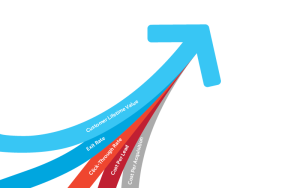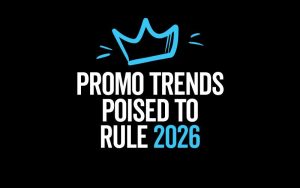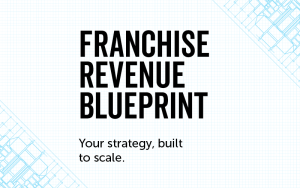Highlights:
- Lead generation, website traffic, and engagement metrics show campaign effectiveness.
- Combining sales growth and cost-efficiency KPIs reveals long-term performance impact.
- KPIs to monitor include:
- Customer Lifetime Value
- Cost Per Acquisition
- Conversion Rate
- Click-Through Rate
- Traffic to Lead Ratio by Channel
- Cost Per Lead
- Lead Close Rate
- Customer Retention Rate
- Exit Rate
[Revamped for 2025]
It’s the holy grail for marketers: proving return on investment (ROI) and return on advertising spend (ROAS). We’ve come a long way from John Wanamaker’s famous quote, “Half the money I spend on advertising is wasted; the trouble is I don’t know which half.” It’s now possible to track the impact of your marketing investment to the penny, so accurate attribution is (actually) attainable.
With so many ways to measure digital advertising ROI and ROAS, we face the challenge of abundance. So let’s strategically track the metrics that matter and determine the best ways to calculate them.
Related: How to Measure ROI on Your SEO
If you’re struggling with where to start, you’re not alone. According to TrackMaven, around 47% of marketers find it difficult to attribute leads to revenue and about 42% don’t know which metrics to track. Whether you’re a marketing team of one, a team leader, or a multi-unit franchise marketer, these key performance indicators (KPIs) correlate closely with measurable business goals.
Every business worth its salt tracks the larger metric of return on investment (ROI) for its expenditures, whether they’re for capital, labor, marketing, or something else. Measuring the dollar benefit received from spending enables savvy spenders to shift dollars to the most profitable efforts.
Generally calculated as ROI % = ((Gain from Investment – Cost of Investment)/Cost of Investment) x 100, applying this equation to any investment lets you know in an instant how it’s performing overall.
Taking this idea one step further, the return on advertising spend (ROAS) tracks the impact of advertising spend. It helps you compare various marketing channels, measure campaign performance, and forecast with accuracy – and it’s most commonly calculated as a ratio. ROAS = Revenue from Ad Spend/Ad Spend, and marketers aim for 3X their investment or higher.
Let’s look at some of the additional digital marketing KPIs you can use for ROI and ROAS tracking. Your specific goals will dictate the mix. If your objective is to get as many leads as possible through your website, you’ll want to track lead conversions. And if you don’t need to worry about the amount of time users spend viewing specific pages, you can skip those metrics. As you’ll see, there are plenty of excellent performance indicators to track.
Related: What Multi-Location Marketers Get Wrong About Attribution
Types of Digital Marketing KPI
KPIs can be defined by the goals they’re trying to achieve. The following are examples:
- Brand awareness KPIs: Include web traffic over time, survey answers, and search volume data.
- Lead generation KPIs: Track number of pages visited, number of requests for estimates, and new account signups.
- Engagement KPIs: Monitor impressions, engagement by a certain timeframe/time zone, post link clicks, and more.
- Sales growth KPIs: Watch revenue growth over a specific time period.
- Social media: Include message volume, shares, retweets, comments, likes, followers, and more.
- Search engine optimization (SEO) KPIs: Note sales and lead conversions, organic visibility, and organic sessions.
- Paid advertising KPIs: Measure costs per lead and costs per acquisition.
Related: Your Guide to Scorecards and Dashboards: Campaign Performance
The Most Important Digital Marketing KPIs
Here are the most telling KPIs to watch:
- Customer Lifetime Value (CLV): It’s critical to calculate how much money an average customer brings in over a lifetime. This number can be seen historically or as a prediction of future spend. Here’s the equation: CLV = Average Revenue per User (ARPU) x 1/Churn.
- Cost Per Acquisition (CPA): CPAs determine how much you spend to get a customer. If it’s more than the projected Customer Lifetime Value, you’ll need to get that cost down. Like Cost Per Lead, the equation is CPA = Total Ad Spend/Total New Customers over a period of time.
- Conversion Rate: This metric is key because it tracks actual conversions, like sales. If you’re measuring conversions by paid, social media, organic, or other channels, you can quickly see which channels are performing best and you can allocate more spend to them. You can also measure conversions by device to find the top producer. Zeroing in on conversions is much more effective than tracking overall traffic numbers. The equation is Conversion Rate % = (Number of Conversions / Total Traffic) x 100.
- Click-Through Rate (CTR): Here’s a familiar one: how many people click on a link after they view it? You can express this percentage by dividing the total number of clicks over the number of impressions to come up with a percentage. It’s an easy way to determine if an email, ad, or social media post is effective (relevant and engaging)—and a high CTR can help boost SEO rankings.
- Traffic to Lead Ratio by Channel: Traffic to Lead measures the number of leads as a ratio to your site or app’s overall traffic. If you get 1,000 people on the site and 100 turn into leads, that’s a 10:1 ratio. When you view this by channel, you can see which drive the highest density of leads. The equation is Traffic to Lead Ratio = Overall Traffic / Number of Leads.
- Cost Per Lead (CPL): How much are you paying per lead? When you spend more on paid ads than they generate in profit, then your ROI/ROAS is negative. Not the place you want to be. Generally, CPLs apply to paid campaigns since
- Lead Close Rate: Although many transactions occur offline, it is important to tie these numbers back into your analytics so you get a clear view of how well you’re moving customers through the whole funnel. Lead close rates can reveal flaws in your marketing; if you get a high number of new leads but a low close rate, you are losing them along the way or potentially not attracting the best leads for your business. The equation is Lead Close Rate % = (Number of Conversions / Number of Leads) x 100.
- Customer Retention Rate: Loyal customers are very valuable, since newer customers generally cost more money to secure. To calculate customer retention rate, use E=number of customers at the end of the period you’re measuring, N=number of customers you gained over that period, and S=number of customers you started with: ((E-N)/S) x 100.
- Exit Rate: You can track each landing page to see where people leave your site and compile a ratio of exits/page views to determine which pages have the highest percentage of exits. Those with high rates can be revamped for more “stickiness” with elements like videos, calls-to-action, or better overall design.
These are the metrics that matter. Depending on your goals, you may only use a handful of these or find even more that make sense for your objectives. With digital marketing KPIs, it’s most important to track the metrics that align with your business objectives.
For multi-location and franchise marketers, these can vary depending on your needs. And if you’re not sure which KPIs to keep an eye on, let us know. We’re dedicated to simplifying marketing success and can help you home in on what to measure. Our data-driven approach fuels everything we do. Whether you’re building a marketing strategy, a digital advertising plan, or a physical advertising plan, we’ll help you track what’s working to ensure everything works better!
Yes, digital advertising ROIs and ROASs are the holy grail—and they’re completely within your grasp.




